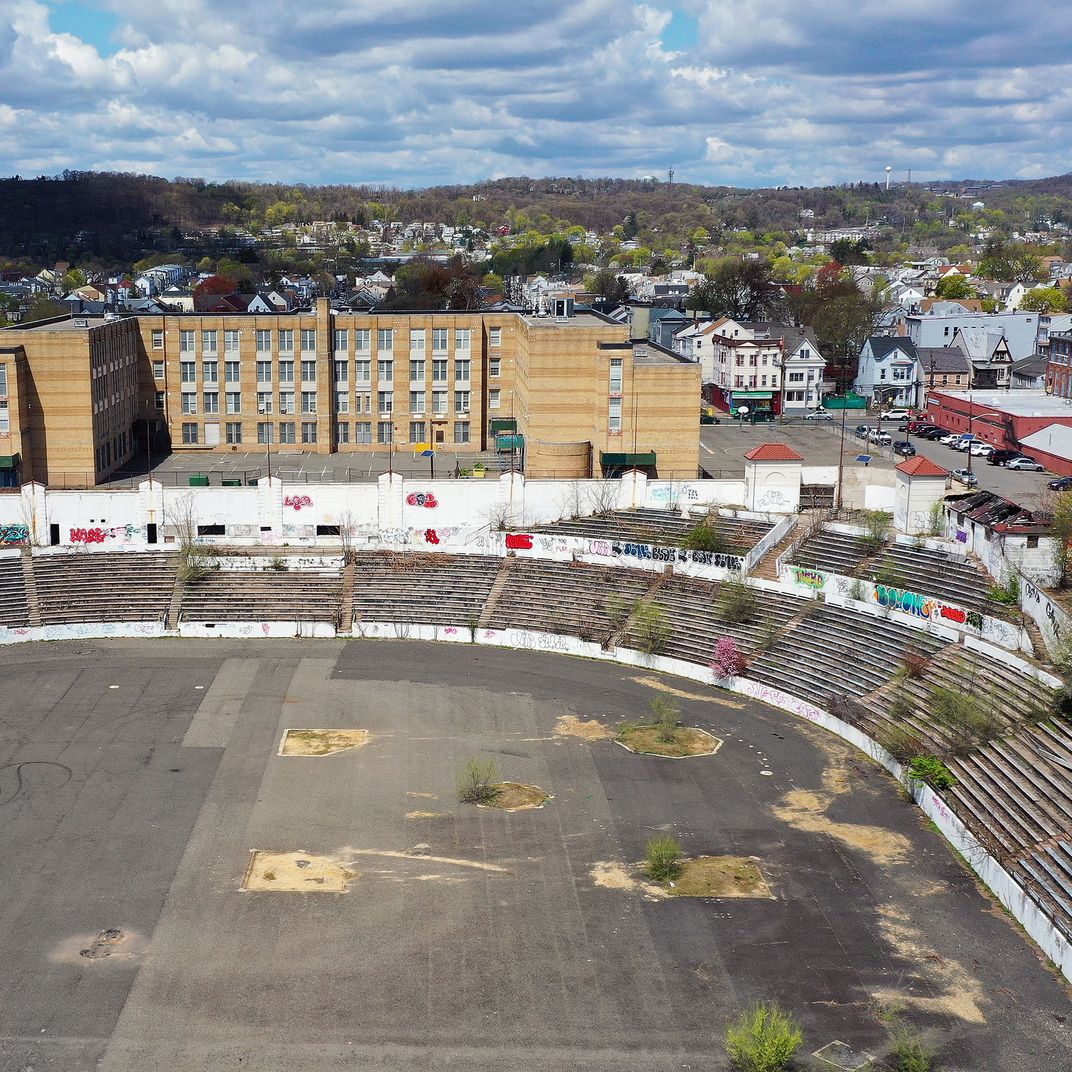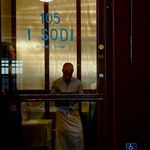
In 1997, Brian LoPinto read a newspaper article about Hinchliffe Stadium, an old ballpark owned by the Paterson, New Jersey, school district that had just been closed and condemned. Then a freshman in college, LoPinto had played a few games there on the varsity squad of Clifton High, and he grew curious about its past. He wrote to the Baseball Hall of Fame to see if the ballpark had any larger significance in the history of the sport.
The letter he received in return told him it did — quite a bit, actually. Hinchliffe is one of just a few Negro League ballparks still standing. (The exact number depends on your definition of “still standing,” but one good estimate puts the number at five.) In its heyday, it was home to two clubs in the Negro Leagues: the New York Black Yankees and the New York Cubans. New Jersey’s Larry Doby — a Hall of Famer who followed Jackie Robinson as Major League Baseball’s second Black player and the American League’s first — had his tryout with the Negro League Newark Eagles there in 1942. Josh Gibson, the slugger known as “the Black Babe Ruth,” played at Hinchliffe. So did Hall of Famers Cool Papa Bell and Monte Irvin.
LoPinto did some more research into the venue’s history, and within a few years, he would co-found the Friends of Hinchliffe Stadium, a grassroots group dedicated not just to saving it from the wrecking ball but to bringing it back to life. As they made their case, the ballpark decayed further: Trees and weeds grew through the seating bowl, vandals sprayed graffiti liberally on the white concrete, and the locker rooms below the stands accrued a lot of water damage. “When you hear condemned, immediately the next thing I thought of was demolition,” he says. “You think about the stadiums that just kind of get demolished — Roosevelt Stadium in Jersey City or the old Newark Bears stadium. We started a conversation, saying, Hey, this is one of the last remaining Negro League stadiums in the country. Maybe we should take care of this place.”
Twenty-six years and one like-minded mayor later, Hinchliffe is about to reopen, restored more or less to its original look. Paterson schools will get to use the park 180 days a year, and much of the rest of the time it will be occupied by the New Jersey Jackals, an independent minor-league baseball team that has relocated from Yogi Berra Stadium in Little Falls. After a tournament of five high-school games inaugurates the new ballpark on May 7, a ceremonial ribbon cutting will be held on May 19, a day before the Jackals take the field for the first time. And there could be high-profile events to follow in the future. Major League Baseball has reportedly looked into whether it could stage a game at Hinchliffe similar to the ones it has had at the Field of Dreams movie site in Iowa. Harold Reynolds, a former big-leaguer and current broadcaster, has been a vocal proponent of such a game, and Paterson officials plan to lobby the league again for such an event once the park is open.
Hinchliffe Stadium was built in 1932, helped along by New Deal funds. It was stylish with Art Deco lines, red terra-cotta roofs, decorative tiles, and bronze reliefs by Gaetano Federici, a Paterson sculptor responsible for at least 40 nearby monuments. Just steps from the Great Falls, the site plan was designed by Olmsted Brothers, the firm founded by the sons of the designer of Central and Prospect Parks. The municipally owned stadium hosted not just baseball but football, motorsports, boxing (Jack Dempsey and Joe Louis served as guest referees for bouts there), and entertainment events (Abbott and Costello performed there on several occasions, perhaps because Costello was a Paterson native). In 1963, the city sold the ballpark for $1 to the school district, which reoriented the baseball diamond but kept the building open. High-schoolers continued to use the stadium until it closed in 1997, after which the decay set in.
Before restoration …
Before restoration …
Before restoration …
… And after, during final preparations for reopening next month.
… And after, during final preparations for reopening next month.
Before restoration …
Before restoration …
Before restoration …
… And after, during final preparations for reopening next month.
… And after, during final preparations for reopening next month.
As LoPinto read up on the stadium, he began to encounter New Jersey residents with a similar desire to save it. While filming a documentary about the city of Paterson, he met Dr. Flavia Alaya, then a professor at Ramapo College and a former chair of the city’s Historic Preservation Commission who had also been thinking a lot about the stadium’s fate. Then, at a meeting at Kennedy High School about the future of Hinchcliffe, LoPinto met Chris Coke, an engineer who grew up running track and playing football there and who gave a presentation about what could be done with the venue. By 2002, they had formed the Friends of Hinchliffe Stadium and began to explore what they could do to preserve the park.
They went to meetings of the City Council and the board of education, wrote op-eds, and continued to do historical research. In the years that followed, the group had some success despite a membership that maxed out at around ten people. In 2010, they helped secure grants totaling $1.3 million that would later go toward a limited project to restore Hinchliffe’s ticket booths. They got a historic-structures report on the ballpark and pushed for it to be recognized for its significance. In 2013, it was designated a National Historic Landmark, and the following year, Congress passed legislation that included the stadium in the Great Falls National Historic Landmark District.
A turning point came in 2009 when a city councilman and former school-board member named Andre Sayegh took a trip to Birmingham, Alabama, to visit Rickwood Field, an impeccably preserved ballpark dating to 1910 that, over the years, had been home to a number of professional clubs, including the Negro League Birmingham Black Barons. Rickwood is considered the gold standard for how an old ballpark can look; it’s well maintained and still has its hand-operated scoreboard and old-timey ads on the outfield wall. The local minor-league team plays one game there every year — the Rickwood Classic — and ballpark lovers from all over the country make a pilgrimage to see this small piece of baseball history in person. Sayegh returned to Paterson with visions of a similar attraction in his hometown.
“We went on a fact-finding mission,” he says. “I said, How did they do it? How did they maintain their treasure?”
Sayegh is a big baseball fan, the type who has been to all 30 big-league ballparks. After his Rickwood trip, he gave a presentation to the Friends of Hinchliffe Stadium, but unlike the group’s members, he thought he might get the project going from within the halls of power. He made restoring Hinchliffe part of his campaign for mayor of Paterson in 2010 and again in 2014, but he lost both races. His third bid for office, four years later, was successful.
Sayegh wasn’t the first mayor of Paterson to support the restoration, but once in office, he lobbied for, and received, state tax credits that made it financially feasible. The $103 million project, which includes a 315-car parking garage and a building with 75 units of affordable senior housing, broke ground in April 2021. Since then, the Friends of Hinchliffe Stadium say they haven’t had much involvement in the redevelopment. “As the bigger entities, the fat cats, got involved in the process of saving the stadium, I think the Friends were more and more sidelined,” says Alaya. “But I’m very glad the original stadium structure is being restored, and I can’t tell you how proud I am of the work I did to make this happen.”
Indeed, while the stadium’s opening may not mark a tidy storybook ending for the Friends of Hinchliffe Stadium’s journey, it’s undeniably a big moment for all involved, especially considering how badly the ballpark was decaying in recent years. “The state of the stadium was pretty tragic,” says Baye Adofo-Wilson, the lead developer on the project, who grew up in Paterson and ran track at Hinchliffe. His group worked with a historic preservationist to identify what could be fully preserved, what needed to be updated, and the limited ways the ballpark could be modernized.
When Hinchliffe reopens, fans will see its original flagpoles from the 1930s. Developers restored the decorative medallions featured throughout the stadium and preserved other touches like the interior windows of the locker rooms. To meet today’s building codes, they added an elevator and expanded the entrances. The new Hinchliffe has an 18-by-36-foot video scoreboard and synthetic turf — plus a new 12,000-square-foot building to house a food court and a museum, scheduled to open in the fall, affiliated with the Negro Leagues Baseball Museum in Kansas City, Missouri.
The reopening is cause for celebration, but it will take more than one-off MLB visits and museumgoers to keep Hinchliffe vital, and no one wants to see history repeat itself. “It’s super-exciting, but there’s also some level of nervousness,” says Coke. “Because you hope it sustains itself and can be a resource to the city and not a strain.”








